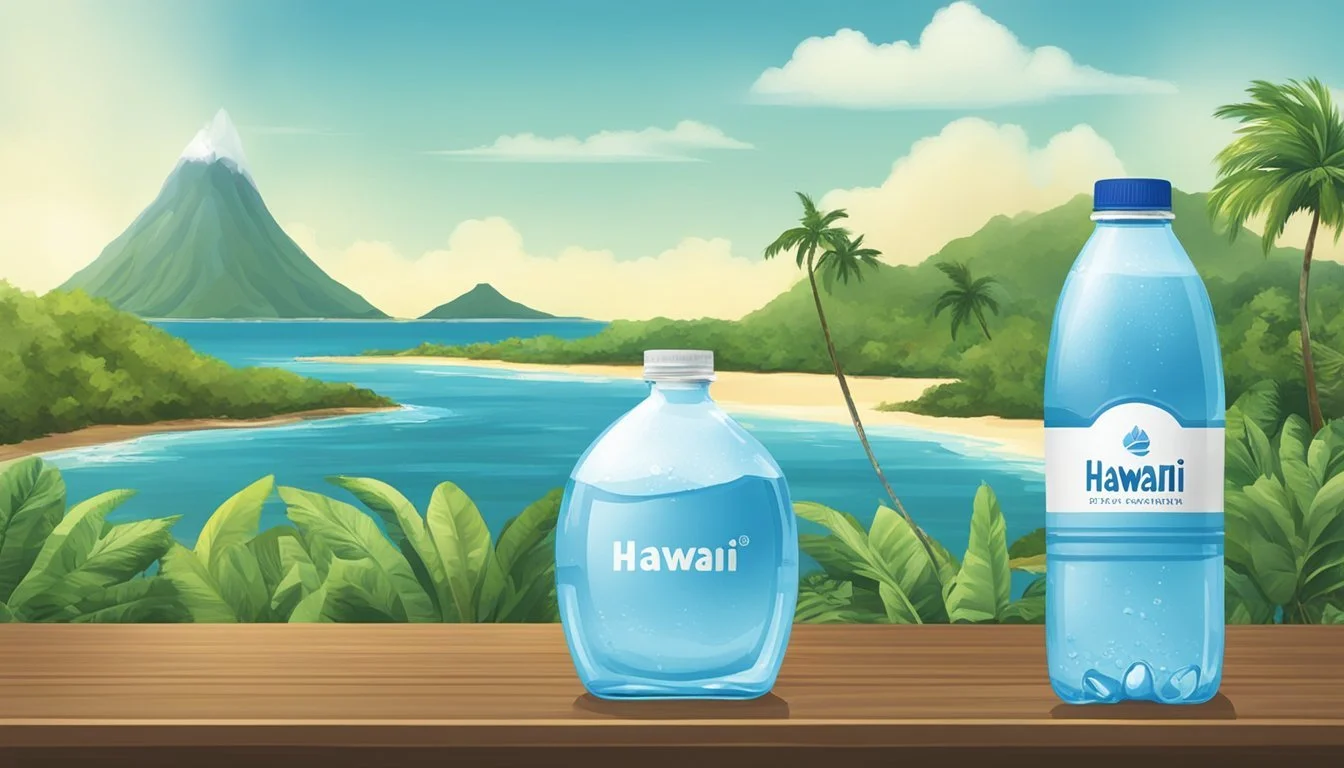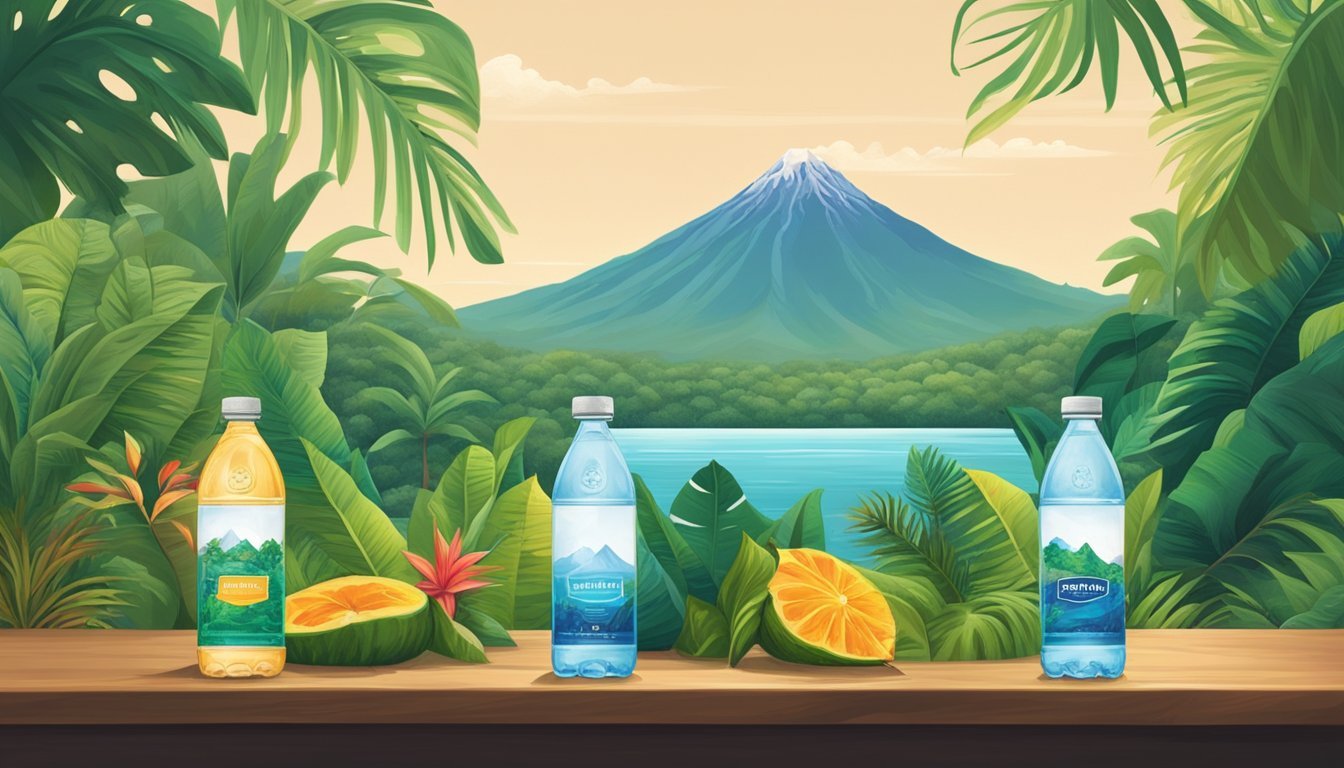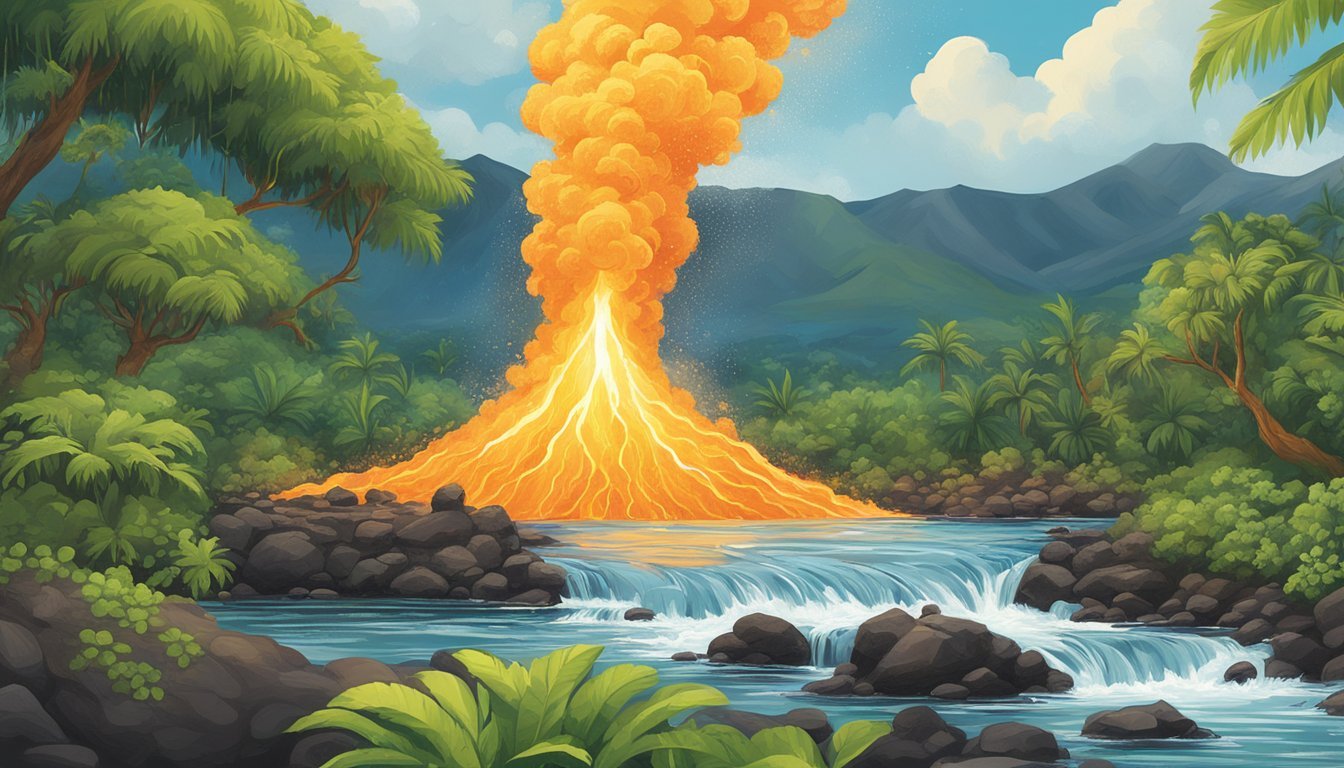Hawai’i Volcanic vs. Richard’s Rainwater
Which Bottled Water Reigns Supreme
When it comes to choosing the best bottled water, comparing brands like Hawai’i Volcanic and Richard’s Rainwater reveals clear differences. Hawai'i Volcanic water is known for its unique sourcing from the Big Island of Hawai'i. The volcanic filtration process adds a slight sweetness and a crisp, clean finish to the water, appealing to many bottled water enthusiasts.
Richard’s Rainwater, on the other hand, offers a different kind of purity by sourcing its water directly from rain. Stemming from the creative efforts of its founder in Texas, Richard’s Rainwater emphasizes sustainability, capturing and purifying rainwater for potable use. It provides a refreshing alternative to traditional groundwater or spring sources, with a soft, smooth taste.
Both companies also prioritize environmental responsibility. Waiākea Hawaiian Volcanic Water focuses on sustainable practices in its production, while Richard’s Rainwater reduces groundwater depletion by utilizing a natural and renewable water source. Readers looking for bottled water that balances taste and eco-conscious practices will find merit in both brands, though preferences may vary based on taste and the importance placed on sustainability practices.
Brand Histories
Both Hawai’i Volcanic and Richard’s Rainwater have unique origins and development stories. These brands have grown significantly by capitalizing on local resources and implementing innovative water collection and filtration methods.
Hawai'i Volcanic History
Hawai’i Volcanic sources its water from the Big Island of Hawaii. Founded with the goal of providing high-quality volcanic water, the brand takes advantage of the natural filtration process through volcanic rock. This process adds essential minerals and results in a distinct taste.
They prioritize sustainability, ensuring that their business practices don’t harm the delicate ecosystems of the Hawaiian Islands. Their marketing often highlights the pristine environment of Hawaii and the natural benefits of volcanic-filtered water.
Richard’s Rainwater History
Richard’s Rainwater, launched by Richard Heinichen, collects rainwater in New Orleans using a zero-waste, chlorine-free filtration system. This innovative approach ensures that the water is free from biological and particulate contaminants. The water is then bottled on-site, resulting in a unique product that champions sustainability.
The company has rapidly expanded since its inception, with projected significant sales growth. Richard's Rainwater partners with entities like Faubourg Brewing Co to optimize their harvesting and bottling processes. They emphasize the purity and eco-friendliness of their rainwater, appealing to environmentally conscious consumers.
Production Process
The production processes of Hawai’i Volcanic and Richard’s Rainwater are distinct, reflecting their unique water sources and purification methods. Richard’s Rainwater focuses on capturing and filtering rainwater, while Hawai’i Volcanic relies on natural filtration through volcanic rock.
Rainwater Collection and Filtration
Richard's Rainwater collects rain directly from the skies using innovative technology. It captures rainwater before it touches the ground, ensuring minimal contamination. A rain capture facility is key in this process, consisting of large collection areas designed to maximize rain harvesting.
Once collected, the rainwater undergoes an extensive filtration and purification process. This multi-step procedure includes sediment filtration, UV light treatment, and ozone disinfection to ensure the water is safe and free from impurities. These steps guarantee that the water is 100% potable, meeting both state and federal regulations. Richard's Rainwater boasts of being the first U.S. brand to offer bottled rainwater.
Source and Natural Filtration
Hawai’i Volcanic sources its water from the Big Island of Hawaii, where the rainwater naturally filters through volcanic rock. This island is known for its fresh rainwater and unique geological formations.
As rainwater percolates through the layers of volcanic rock, it picks up essential minerals and undergoes natural filtration. This journey from rainfall to aquifer takes several years, ensuring a natural purification process. The water is then extracted from deep aquifers, providing a pure and mineral-rich product. Hawai’i Volcanic prides itself on the natural filtration provided by the volcanic environment, which imparts a distinct taste and high mineral content to the water.
Packaging and Materials
Hawai’i Volcanic and Richard’s Rainwater each use distinct packaging choices aimed at enhancing user experience and minimizing environmental impact. Both brands focus on sustainability but approach it in varied ways.
Glass vs. Plastic Bottles
Hawai’i Volcanic uses predominantly plastic bottles for their water packaging. Plastic bottles are lightweight and convenient but raise environmental concerns due to their long decomposition time and widespread pollution. Richard’s Rainwater, by contrast, has made a conscious decision to eliminate plastic bottles entirely. They now use 100% glass bottles or aluminum cans.
While glass bottles are heavier and more fragile, their reuse and recycling rates are significantly higher than plastic. This shift towards glass and aluminum aims to reduce the environmental footprint associated with single-use plastics.
Sustainability of Materials
Hawai’i Volcanic’s use of plastic bottles may be less sustainable compared to Richard’s Rainwater. Plastic packaging often ends up in landfills and oceans, posing significant ecological threats. In contrast, Richard’s Rainwater’s commitment to glass and aluminum packaging marks a substantial move towards sustainability.
Glass bottles can be recycled endlessly without loss of quality, making them an environmentally friendly option. Similarly, aluminum cans are highly recyclable, requiring less energy to process compared to plastic. Richard’s Rainwater’s plastic-free strategy underscores their emphasis on reducing waste and promoting sustainable consumption.
Health and Quality Standards
Both Hawai’i Volcanic and Richard’s Rainwater emphasize purity through rigorous filtration processes. Their compliance with bottled water standards ensures that contaminants such as chlorine, fluoride, and lead are kept in check, providing consumers with clean water.
Purity and Contamination
Hawai’i Volcanic boasts a stringent purification system that aims to eliminate contaminants. With a focus on minimizing ammonia, lead, and other harmful substances, their water is often marketed as pure and safe for consumption.
Richard’s Rainwater, on the other hand, uses a virtually zero-waste filtration system that optimizes water cleanliness. By ensuring that contaminants like chlorine and fluoride are filtered out, Richard’s Rainwater achieves a high level of purity. Both brands aim to provide clean water, but their methods and results can vary.
Bottled Water Standards Compliance
Hawai’i Volcanic adheres to strict bottled water standards set by regulatory bodies. This includes meeting the Maximum Contaminant Level Goals (MCLG) for various substances. Regular testing and quality checks are conducted to ensure compliance, which is crucial for consumer safety.
Richard’s Rainwater also complies with all recommended standards for bottled water. Their system ensures more freshwater availability by maximizing filtration efficiency. By adhering to both local and national water quality standards, they guarantee a product that is not only safe but also sustainable.
Both brands prioritize health and safety through their adherence to established water quality benchmarks.
Environmental Impact
Both Hawai’i Volcanic and Richard’s Rainwater aim to offer environmentally friendly bottled water products. Their approaches to resource use and sustainability provide unique benefits and challenges.
Renewable Resources and Aquifer Impact
Hawai’i Volcanic utilizes water sourced from the slopes of Hawaiian volcanoes. They bottle less than 0.003% of the total water available, minimizing their aquifer impact. This method contributes to the sustainability of local water resources.
Richard’s Rainwater collects rainwater from various U.S. locations. This approach emphasizes the use of a renewable resource without depleting local groundwater. By leveraging natural rainfall, they avoid significant aquifer impact, contributing positively to environmental sustainability.
Carbon Footprint and Global Warming
Hawai’i Volcanic focuses on sustainability throughout their production and packaging processes. They aim to reduce carbon emissions, though specific metrics on their carbon footprint are not detailed.
Richard’s Rainwater takes a distinctive route by sourcing rainwater, which can reduce the overall carbon footprint compared to traditional bottled water collection methods. Their dedication to using local rainwater and purifying it efficiently positions them as a climate-friendly option.
Both companies strive to offer environmentally conscious products, though their methods differ significantly. These variances highlight the unique strengths and areas for improvement in their environmental impact strategies.
Cultural and Community Contributions
Hawai’i Volcanic and Richard’s Rainwater both emphasize their connections to local communities and cultural identities, which plays a significant role in their branding and marketing strategies. These factors are crucial for consumers who value sustainability and local engagement.
Local Community Engagement
Hawai’i Volcanic has consistently shown its support for local communities in Hawai’i. Through various initiatives, they invest in preserving natural resources and promoting water conservation. For example, a portion of their profits is allocated to programs that address local water issues and educational campaigns about sustainability.
Richard’s Rainwater, on the other hand, contributes to local communities by sourcing its water directly from rainfall and ensuring minimal environmental impact. This method not only supports local water conservation but also aligns with community values of sustainability and environmental stewardship. Their partnerships with local non-profits further amplify their commitment to community well-being.
Branding and Cultural Identity
Hawai’i Volcanic's branding heavily revolves around its Hawaiian roots. The company integrates Hawaiian cultural elements and local languages into its marketing materials. Terms like Ola i ka wai ("water is life") are used to resonate with both locals and those who hold Hawaiian culture in high regard. This cultural immersion strengthens the brand's identity and appeal.
Richard’s Rainwater focuses on the purity and simplicity of rainwater, aligning its brand with notions of untouched nature and environmental consciousness. Their branding strategy emphasizes clean, renewable resources, aiming to attract consumers who prioritize sustainability. The brand communicates its commitment through transparent practices and showcasing their environmental benefits.
Product Range and Varieties
Both Hawai’i Volcanic and Richard’s Rainwater offer a range of products catering to different consumer preferences, including both still and sparkling water options, as well as flavored and enhanced variations to suit various tastes and hydration needs.
Still vs. Sparkling Water
Richard’s Rainwater focuses on rainwater collection, using proprietary treatments to ensure purity and sustainability. Their product line includes both still and sparkling rainwater options. The still version is renowned for its crisp, refreshing taste and minimal mineral content.
Hawai’i Volcanic, sourced from Hawaiian volcanic regions, provides both still and sparkling water. Their still water has a naturally alkaline pH and a hint of volcanic minerals, which is appealing to consumers seeking a premium hydration experience. The sparkling variant offers a clean, effervescent taste with a touch of volcanic essence.
Brand Still Water Sparkling Water Richard’s Rainwater Rainwater with minimal minerals Sparkling rainwater Hawai’i Volcanic Alkaline volcanic water Effervescent volcanic water
Flavored and Enhanced Water Options
Richard’s Rainwater tends to focus on the purity and sustainability of its water, therefore, it currently does not offer flavored options. Their emphasis remains on providing a clean, unaltered drinking experience with an emphasis on sustainability and eco-friendliness.
Hawai’i Volcanic, on the other hand, caters to a broader market with a variety of enhanced and flavored water options. They infuse their waters with natural electrolytes like potassium and magnesium to support athletic performance and recovery. Some varieties are also flavored with subtle hints of tropical fruits, appealing to those seeking a refreshing taste while staying hydrated.
Brand Flavored Water Options Enhanced Water Options Richard’s Rainwater None None Hawai’i Volcanic Tropical fruit flavors Electrolyte-infused variants
These diverse product ranges highlight how each brand caters to different consumer preferences, with Richard’s Rainwater focusing on purity and sustainability, while Hawai’i Volcanic balances purity with taste and functionality.
Market Presence and Availability
Both Hawai’i Volcanic and Richard’s Rainwater have established significant market presences, with a variety of distribution methods including physical retail stores and online sales channels.
Retailer Distribution
Hawai’i Volcanic can be found at several major retailers, such as Whole Foods Market, Sprouts, and Kroger. These stores are known for their focus on natural and healthy products, which aligns with the brand's image of purity and natural sourcing. Central Market and HEB also stock this volcanic water, making it widely available across many states.
Richard’s Rainwater is also present in numerous retail locations, but its focus tends to be on environmentally conscious outlets. Whole Foods Market and Sprouts are key distributors. Additionally, Albertsons carries the brand, providing ample access to customers who prefer in-store purchases.
Online Availability and Sales Channels
Both brands have embraced online sales to reach wider audiences. Amazon is a significant sales channel for both Hawai’i Volcanic and Richard’s Rainwater, allowing for convenient purchasing with direct home delivery.
Hawai’i Volcanic also has its own official website for direct sales, offering various deals and subscription options. Richard’s Rainwater follows a similar model, with its website providing detailed product information and direct purchasing options.
Online wellness stores might also stock these products, catering to customers who seek specific health-oriented brands. The combination of these online platforms ensures that both Hawai’i Volcanic and Richard’s Rainwater remain easily accessible, regardless of geographic location.
Consumer Preference Factors
Consumers prioritize essential aspects when choosing between Hawai’i Volcanic and Richard’s Rainwater, such as taste profile, brand loyalty, cost, and accessibility.
Taste Profile and Mineral Content
Taste is a significant determinant for bottled water preference. Hawai’i Volcanic, sourced from Hawaiian volcanic springs, is known for its rich mineral content, offering a unique, slightly alkaline taste.
In contrast, Richard’s Rainwater, which uses a proprietary filtration system to purify rainwater, has a crisp and neutral taste. While it lacks the mineral richness of Hawai’i Volcanic, it appeals to those who prefer a straightforward, clean flavor.
Both brands offer something distinct, catering to diverse taste preferences.
Brand Loyalty and Image
Brand loyalty plays a vital role in consumer choice. Hawai’i Volcanic leverages the pristine, natural image associated with Hawai'i, marketing itself as pure and exotic.
Richard’s Rainwater emphasizes its eco-friendly approach, being the first U.S. company to bottle rainwater with a virtually zero-waste process. This appeals to environmentally conscious consumers.
Path and Fiji also influence this segment, with Fiji known for its artisanal, premium quality and Path for its sustainability ethos. Brand image significantly impacts repeat purchases.
Cost and Accessibility
Cost and accessibility are critical factors affecting consumer decisions. Hawai’i Volcanic, with its premium branding, tends to be priced higher, which could be a barrier to some consumers.
Richard’s Rainwater, while also leaning towards a premium image, offers competitive pricing, making it more accessible. Availability in local and large retail chains further influences consumer preferences.
Price-conscious consumers might choose Fiji or other bottled waters that balance quality and cost effectively. Accessibility in terms of distribution channels and availability in stores or online platforms also heavily sways buying decisions.
Future Outlook and Trends
Hawai’i Volcanic and Richard’s Rainwater are both pushing forward with innovative strategies and sustainable practices to remain competitive in the bottled water market.
Sustainable Practices and Growth
Both Hawai’i Volcanic and Richard’s Rainwater are committed to sustainability. Hawai’i Volcanic focuses on minimal environmental impact, by bottling less than 0.003% of the water yielded at the slopes, ensuring responsible sourcing. They also prioritize eco-friendly packaging and carbon-neutral practices.
Richard’s Rainwater emphasizes its unique rainwater collection process, which reduces groundwater depletion. Their production facilities rely on renewable energy, contributing to their goal of minimizing carbon emissions. This focus is expected to resonate with environmentally-conscious consumers, driving growth while supporting sustainability.
Innovations in Bottled Water Industry
In the evolving bottled water industry, innovation is key. Hawai’i Volcanic leverages its unique volcanic filtration process, enhancing water quality. They also invest heavily in technology-driven quality control, ensuring each bottle meets high standards.
Richard’s Rainwater adopts advanced filtration and purification methods to maintain the integrity of rainwater. As they expand their production capacity, they are likely to invest in new technologies that improve efficiency and quality. Both brands are expected to explore untapped markets and new product lines to stay ahead in the competitive bottled water market.
More About Hawai’i Volcanic
Acqua Pana vs Hawaii Volcanic: Which Bottled Water is Better?
Antipodes vs Hawaii Volcanic: Which Bottled Water is Better?
Aqua Carpatica vs Hawaii Volcanic: Which Bottled Water is Better?
Arrowhead vs Hawaii Volcanic: Which Bottled Water is Better?
Boxed Water vs Hawaii Volcanic: Which Bottled Water is Better?
Castle Rock vs Hawaii Volcanic: Which Bottled Water is Better?
Core Hydration vs Hawaii Volcanic: Which Bottled Water is Better?
Deer Park vs Hawaii Volcanic: Which Bottled Water is Better?
Hawaii Volcanic vs 1907water: Which Bottled Water is Better?
Hawaii Volcanic vs Alkaline88: Which Bottled Water is Better?
Hawaii Volcanic vs Big Chill: Which Bottled Water is Better?
Hawaii Volcanic vs BodyArmor: Which Bottled Water is Better?
Hawaii Volcanic vs Cascade Mountain: Which Bottled Water is Better?
Hawaii Volcanic vs CBD Living: Which Bottled Water is Better?
Hawaii Volcanic vs Crystal Geyser: Which Bottled Water is Better?
Hawaii Volcanic vs Crystal Lake: Which Bottled Water is Better?
Hawaii Volcanic vs Essence pH10: Which Bottled Water is Better?
Hawaii Volcanic vs Kirkland Signature: Which Bottled Water is Better?
Hawaii Volcanic vs Liquid Death: Which Bottled Water is Better?
Hawaii Volcanic vs Open Water: Which Bottled Water is Better?
Hawaii Volcanic vs Proud Source: Which Bottled Water is Better?
Hawaii Volcanic vs Pure Life: Which Bottled Water is Better?
Hawaii Volcanic vs Purely Sedona: Which Bottled Water is Better?
Hawaii Volcanic vs Simple Truth: Which Bottled Water is Better?
Hawaii Volcanic vs Talking Rain AQA: Which Bottled Water is Better?
Hawaii Volcanic vs Weird Water: Which Bottled Water is Better?
Hawaii Volcanic vs Whole Foods 365: Which Bottled Water is Better?
Hawaii Volcanic vs Whole Foods Italian Still Mineral water: Which Bottled Water is Better?
Hawaiian Springs vs Hawaii Volcanic: Which Bottled Water is Better?
Ice Mountain vs Hawaii Volcanic: Which Bottled Water is Better?
Icelandic Glacial vs Hawaii Volcanic: Which Bottled Water is Better?
Just Water vs Hawaii Volcanic: Which Bottled Water is Better?
Mountain Valley Spring Water vs Hawaii Volcanic: Which Bottled Water is Better?
Nestle Pure Life vs Hawaii Volcanic: Which Bottled Water is Better?
Poland Spring vs Hawaii Volcanic: Which Bottled Water is Better?
San Pellegrino vs Hawaii Volcanic: Which Bottled Water is Better?
Smartwater vs Hawaii Volcanic: Which Bottled Water is Better?
Solan de Cabras vs Hawaii Volcanic: Which Bottled Water is Better?
Topo Chico vs Hawaii Volcanic: Which Bottled Water is Better?
Zephyrhills vs Hawaii Volcanic: Which Bottled Water is Better?
More About Richard’s Rainwater
Acqua Pana vs Richard's Rainwater: Which Bottled Water is Better?
Alkaline88 vs Richard's Rainwater: Which Bottled Water is Better?
Antipodes vs Richard's Rainwater: Which Bottled Water is Better?
Aqua Carpatica vs Richard's Rainwater: Which Bottled Water is Better?
Aquafina vs Richard's Rainwater: Which Bottled Water is Better?
Arrowhead vs Richard's Rainwater: Which Bottled Water is Better?
Boxed Water vs Richard's Rainwater: Which Bottled Water is Better?
Cascade Mountain vs Richard's Rainwater: Which Bottled Water is Better?
Castle Rock vs Richard's Rainwater: Which Bottled Water is Better?
Cirro vs Richard's Rainwater: Which Bottled Water is Better?
Richard's Rainwater vs HFactor: Which Bottled Water is Better?
Core Hydration vs Richard's Rainwater: Which Bottled Water is Better?
Crystal Geyser vs Richard's Rainwater: Which Bottled Water is Better?
Deer Park vs Richard's Rainwater: Which Bottled Water is Better?
Erewhon vs Richard's Rainwater: Which Bottled Water is Better?
Essentia vs Richard's Rainwater: Which Bottled Water is Better?
Eternal vs Richard's Rainwater: Which Bottled Water is Better?
Ethos vs Richard's Rainwater: Which Bottled Water is Better?
Evian vs Richard's Rainwater: Which Bottled Water is Better?
Hawaiian Springs vs Richard's Rainwater: Which Bottled Water is Better?
Ice Mountain vs Richard's Rainwater: Which Bottled Water is Better?
Icelandic Glacial vs Richard's Rainwater: Which Bottled Water is Better?
Just Water vs Richard's Rainwater: Which Bottled Water is Better?
Kroger vs Richard's Rainwater: Which Bottled Water is Better?
LIFEWTR vs Richard's Rainwater: Which Bottled Water is Better?
Liquid Death vs Richard's Rainwater: Which Bottled Water is Better?
Mananalu vs Richard's Rainwater: Which Bottled Water is Better?
Mountain Valley Spring Water vs Richard's Rainwater: Which Bottled Water is Better?
Nestle Pure Life vs Richard's Rainwater: Which Bottled Water is Better?
Origin vs Richard's Rainwater: Which Bottled Water is Better?
Ozarka vs Richard's Rainwater: Which Bottled Water is Better?
Penta vs Richard's Rainwater: Which Bottled Water is Better?
Perrier vs Richard's Rainwater: Which Bottled Water is Better?
Poland Spring vs Richard's Rainwater: Which Bottled Water is Better?
Purely Sedona vs Richard's Rainwater: Which Bottled Water is Better?
Richard's Rainwater vs 1907water: Which Bottled Water is Better?
Richard's Rainwater vs 7-Select: Which Bottled Water is Better?
Richard's Rainwater vs Action: Which Bottled Water is Better?
Richard's Rainwater vs Big Chill: Which Bottled Water is Better?
Richard's Rainwater vs Big Win: Which Bottled Water is Better?
Richard's Rainwater vs BodyArmor: Which Bottled Water is Better?
Richard's Rainwater vs CBD Living: Which Bottled Water is Better?
Richard's Rainwater vs Crystal Lake: Which Bottled Water is Better?
Richard's Rainwater vs Dasani: Which Bottled Water is Better?
Richard's Rainwater vs Essence pH10: Which Bottled Water is Better?
Richard's Rainwater vs Kirkland Signature: Which Bottled Water is Better?
Richard's Rainwater vs Open Water: Which Bottled Water is Better?
Richard's Rainwater vs Ophora: Which Bottled Water is Better?
Richard's Rainwater vs Proud Source: Which Bottled Water is Better?
Richard's Rainwater vs Pure Life: Which Bottled Water is Better?
Richard's Rainwater vs Ramona: Which Bottled Water is Better?
Richard's Rainwater vs Refreshe: Which Bottled Water is Better?
Richard's Rainwater vs Simple Truth: Which Bottled Water is Better?
Richard's Rainwater vs Skyra: Which Bottled Water is Better?
Richard's Rainwater vs Talking Rain AQA: Which Bottled Water is Better?
Richard's Rainwater vs The Well: Which Bottled Water is Better?
Richard's Rainwater vs Weird Water: Which Bottled Water is Better?
Richard's Rainwater vs Whole Foods 365: Which Bottled Water is Better?
Richard's Rainwater vs Zenwtr: Which Bottled Water is Better?
San Pellegrino vs Richard's Rainwater: Which Bottled Water is Better?
Smartwater vs Richard's Rainwater: Which Bottled Water is Better?
Solan de Cabras vs Richard's Rainwater: Which Bottled Water is Better?
Starkey vs Richard's Rainwater: Which Bottled Water is Better?
Tahoe vs Richard's Rainwater: Which Bottled Water is Better?
Topo Chico vs Richard's Rainwater: Which Bottled Water is Better?
Tru Alka vs Richard's Rainwater: Which Bottled Water is Better?
Volvic vs Richard's Rainwater: Which Bottled Water is Better?
Waiakea vs Richard's Rainwater: Which Bottled Water is Better?
Whole Foods Italian Still Mineral water vs Richard's Rainwater: Which Bottled Water is Better?
Zephyrhills vs Richard's Rainwater: Which Bottled Water is Better?











